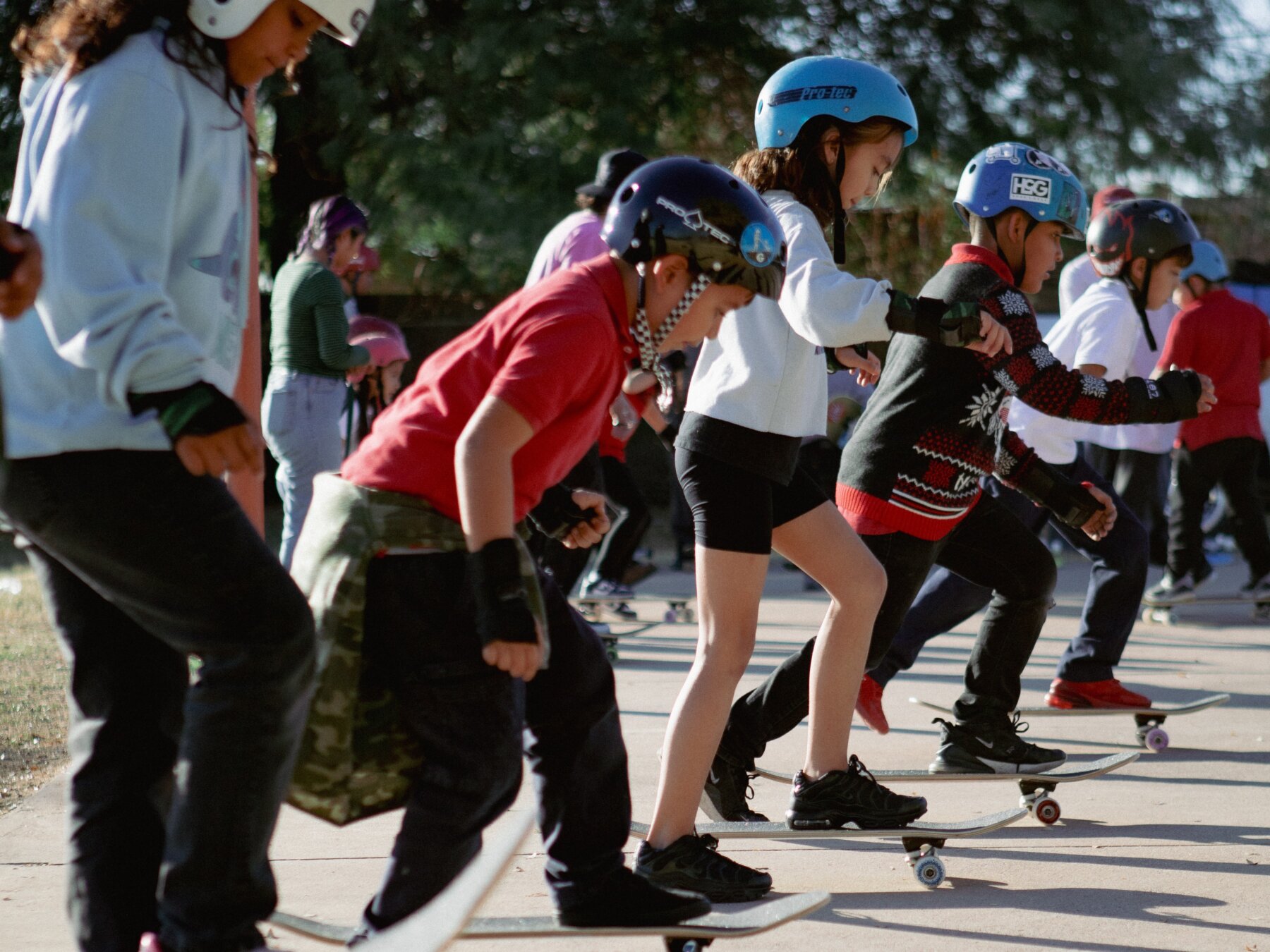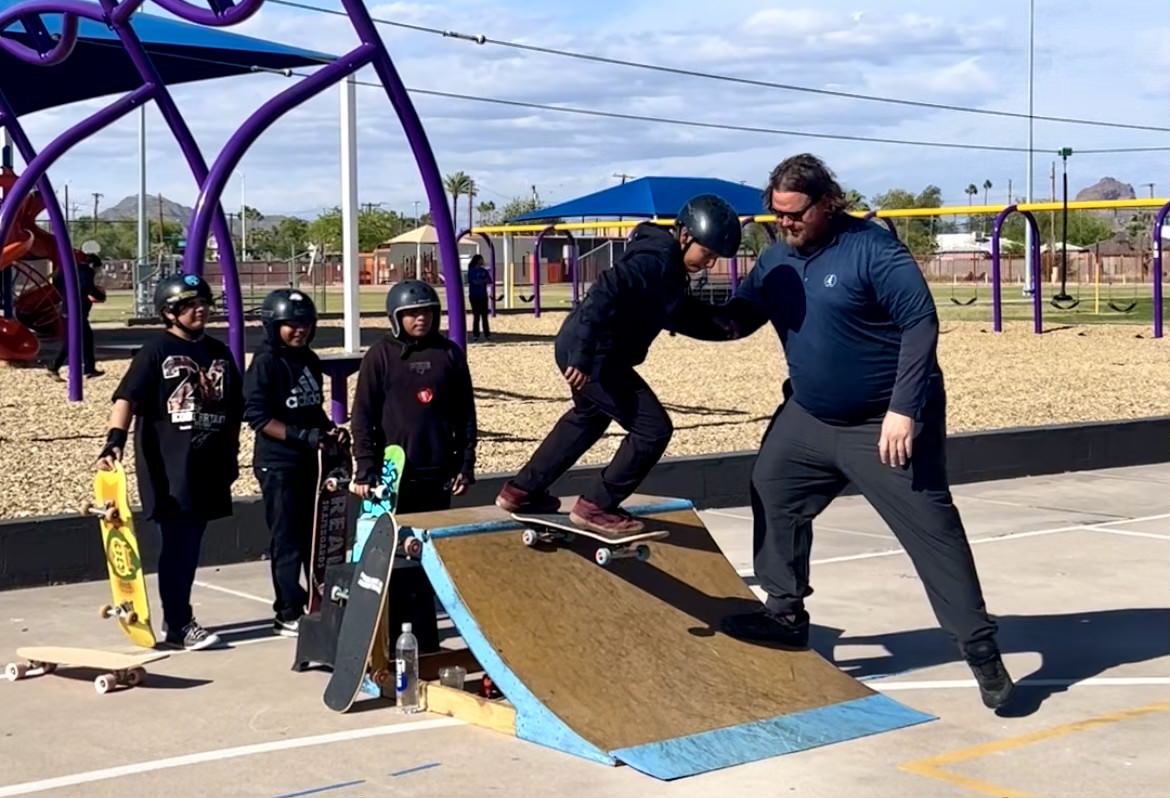
On a dry April afternoon in Phoenix, a group of 15 second and third graders gathered around a white pickup truck stacked with skateboards. As they fastened their wrist guards, kneepads and helmets, they buzzed with excitement over an end-of-year surprise — a donation of cruisers from a local Vans store.
“Can we take them home and ride them over the summer?” one of the students asked Tim Ward, the director of Skate After School. It was the last day of the program before it’d reconvene in the fall. “These are yours now,” he said. “Be careful, these cruisers are fast.”
Skate After School provides free skateboarding lessons to elementary schools across Phoenix that fall under the federal Title I program, which provides aid to schools with low-income students. It started with professional skateboarder Ryan Lay and Ward tapping their local connections to create an informal after-school gathering of eight kids a dozen years ago, and now serves 200 students across eight schools every year. In 2022, the organization collaborated with Phoenix Parks and Recreation to redesign an underused tennis court at Perry Park into a beginner-friendly public skate plaza. Today, the program remains one of the few free after-school skateboarding offerings in the country.

When Ward asked the students who planned to return to Skate After School in the fall, almost all raised their hands. “I want to get better and bring my board back next year,” a second grader named Sophia said.
While the program grows skaters, it also offers a reliable and safe learning space for the mostly Latino students it serves. Zamara Fabela, Skate After School’s community outreach coordinator, said schools that receive Title I grant money often look for after-school programs to fund, but there’s a lack of quality options. With its minimal equipment and lower barrier to entry, Skate After School fills the extracurricular gap in a city where kids can be outside year-round.
“Richer schools have a ton of sports and resources that have high costs,” Fabela said. “For skateboarding, all you need is a board and an open space.”
The community and mental health benefits of skateboarding
After selecting their skateboards, the Skate After School kids warmed up by cruising back and forth on C.J. Jorgensen Elementary’s basketball court. Next, it was time to form a circle and show off their tricks. De La Torre, who’s been in the program for two years, demonstrated a trick she recently learned — an ollie — by pushing down the tail end of her board to tilt it upward. “It took me a couple weeks, but I got the hang of it,” she said.
Skateboarding, which emerged on the West Coast in the 1950s as a counterculture sport for anti-establishment misfits, can trace its roots back to Native Hawaiian surfboards and land sleds. Through the decades, its influence has become embedded in pop culture and it even became an Olympic sport in 2021. Around 6.4 million Americans ride a skateboard every year.
Though it’s an individual sport, skateboarding fosters diverse communities because it’s done outdoors in public spaces. A 2020 study from the University of Southern California and the Tony Hawk Foundation found that skateboarding helps youth with “developing more complex networks of friends and allies including intergenerational and crosscultural relationships” and that a skate park provides “a unique space for people from different backgrounds to connect.” It also concluded that skateboard-related nonprofits like Skate After School “created an avenue for respondents to informally develop friendships with other skaters — and more formally with mentors.”
Skateboarding also has many community health benefits, said Alan Gomez, a justice and social inquiry professor at Arizona State University. “Studies show that skating is good for youth mental health because they get to be outside, get exercise and create community,” he said. “Skate After School integrates these students into a social environment that is welcoming and not hierarchical.”
Shamus Flatly, a 25-year-old medical school student who has volunteered with Skate After School for two years, said he wishes he’d had someone helping him when he started skateboarding at age 10. “I love being a mentor to the kids and guiding them through new tricks,” he said.
Even school teachers are getting something out of the program. Machan Elementary technology teacher Jessie Giambra said she always wished she could skate, so when Skate After School came to the school, she joined the lessons. She said she’s observed her students’ confidence and focus improve over the course of the program. Some of her students have even entered skate competitions in Phoenix’s thriving skate scene. “Skate After School is embedding them into the skate community early on, so they aren’t strangers when they show up to a skate park,” she said.
After finishing the program, many students continue skating and keep in touch with their mentors. Mario Trujillo, a high school senior who was in the program from sixth to eighth grade, has joined Ward and Zabela for a weeklong Oregon skate camp last summer where he got to meet skaters who flew in from Central America and Europe. He says skating will always remain his outlet for having fun. “I like getting out there and challenging myself with friends by learning new tricks,” he said.
The social impact of skating
Over the years, Skate After School has expanded beyond after-school programs to create more community skateboarding spaces. Along with the Arizona State University Women’s Skate Club, Skate After School is a local host for Slow Impact, an annual skateboarding and social impact conference in Tempe, Arizona. This year, the conference drew over 200 people and included panels on sober skating, skateboarding’s impact on inclusive urban design, skating on Native lands and the Palestinian skateboarding scene. “There’s a natural connection between nonprofit work and skateboarding,” Gomez said. “Our community has always been involved and outspoken about social justice issues.”
Perry Park Plaza is another Skate After School initiative bringing Phoenix-area skaters together. The skate park in east Phoenix, a flat open area with colorful ramps dotting the former tennis court, was designed with beginner-friendly ramps in mind.
On a recent Friday night, about 20 skaters took turns on the ramps at the brightly lit plaza. Haley Changet and Hannah Krumholz said they have skated at the park weekly since it opened.
“Before this park was built, most parks were on the outskirts of Phoenix. There was nothing as central as this,” Changet said. Krumholz added that most parks have bowls or quarter pipes, but Perry Park is special for being a street skating park with objects found in a city. “The ramps are similar to what you’d see on the streets because they imitate curbs and ledges,” Krumholz said.
This was the intention of Skate After School, said Ward — to bring the welcoming, friendly energy from the student programs to the park so anyone in Phoenix could have fun learning how to skate. “We designed the park with our kids in mind, so that when they take their skating to the open spaces, brand-new skaters like them can join in,” Ward said.
Fabela says she often runs into former Skate After School students at Perry Park. “It’s rewarding to see that after graduating from our program, they’re still progressing with skating and becoming a part of the larger skate scene in Phoenix,” she said.


